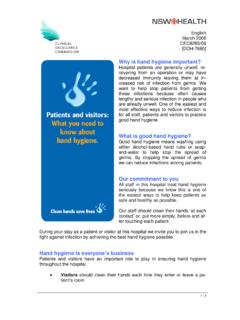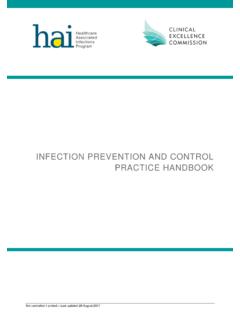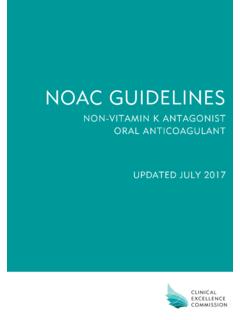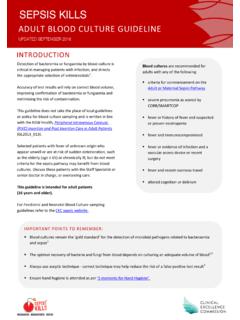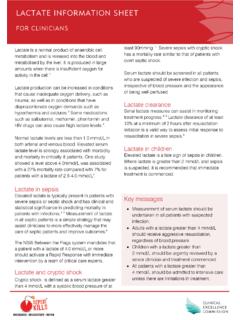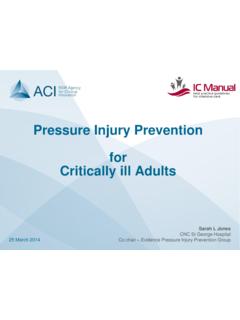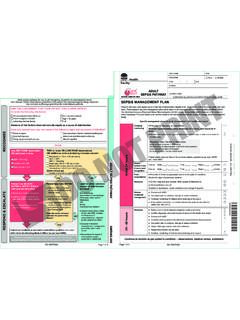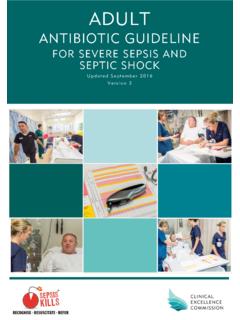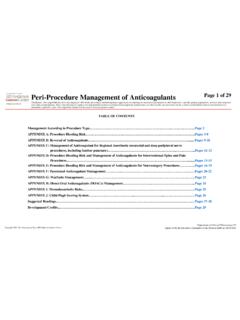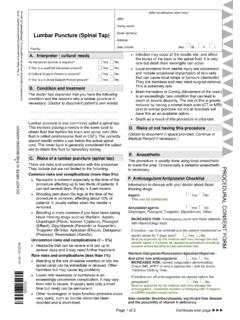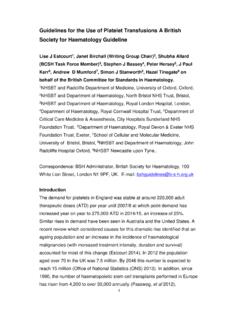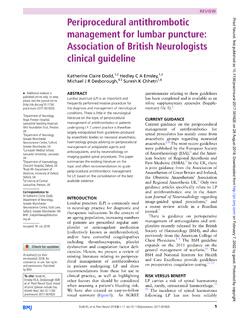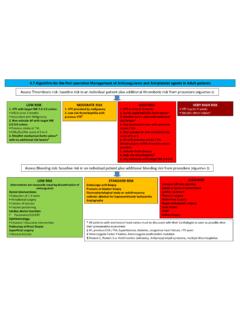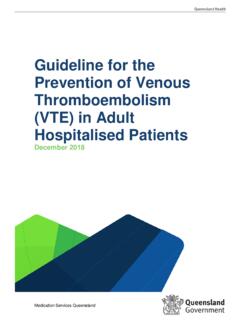Transcription of INTRAVENOUS UNFRACTIONATED HEPARIN RECOMMENDED …
1 Introduction This standard applies to inpatients aged over 16 years treated with INTRAVENOUS UNFRACTIONATED HEPARIN . Do not use this standard for the management of INTRAVENOUS UNFRACTIONATED HEPARIN in specific medical interventions, for example, renal replacement therapy, thermodilution catheter management (for example, Swan Ganz catheter) or Extracorporeal Membrane Oxygenation (ECMO). This standard includes guidance on: UNFRACTIONATED HEPARIN indications, doses and contraindications monitoring requirements HEPARIN products HEPARIN reversal perioperative management and other considerations.
2 An example of an INTRAVENOUS UNFRACTIONATED HEPARIN infusion nomogram is included. A local nomogram must be developed according to the local laboratory reference range. Indications for INTRAVENOUS UNFRACTIONATED HEPARIN Treatment with an INTRAVENOUS UNFRACTIONATED HEPARIN infusion is reserved for patients where treatment with low molecular weight HEPARIN is contraindicated, for example, in severe renal impairment or when rapid offset of anticoagulant effect is required(1) for example, surgery. Contraindications to HEPARIN therapy include: Known hypersensitivity to HEPARIN or pork products.
3 History of HEPARIN induced thrombocytopenia (HIT) (consult with haematology specialist). Patients with severe thrombocytopenia (consult with haematology specialist). Circumstances where the required blood coagulation tests cannot be performed at the necessary intervals. Patients with uncontrolled active bleeding state. Commencing treatment The following baseline laboratory tests should be performed prior to commencing treatment. The patient should be further investigated if results are abnormal: full blood count (FBC) prothrombin time (PT) activated partial thromboplastin time (aPTT)* urea, electrolytes and creatinine.
4 * INTRAVENOUS UNFRACTIONATED HEPARIN therapy may not be suitable if the baseline aPTT is prolonged. Measure actual body weight. Consider stopping antiplatelet agents due to increased risk of bleeding, if clinically appropriate. Check if any other anticoagulants are prescribed and cease if appropriate. Monitoring for HEPARIN Induced Thrombocytopenia (HIT) Check the platelet count on commencement and then every three days while on INTRAVENOUS UNFRACTIONATED HEPARIN therapy. Seek specialist haematology advice if thrombocytopenia develops or the platelet count falls more than 30 to 50 per cent below baseline (1).
5 INTRAVENOUS UNFRACTIONATED HEPARIN protocols This standard includes two protocols (see page 2): A Standard Risk Protocol for use in atrial fibrillation, venous and arterial thromboembolic disease, prosthetic heart valves. A Higher-Bleeding Risk Protocol for circumstances where the risk of bleeding needs to be minimised, for example acute coronary syndrome. INTRAVENOUS UNFRACTIONATED HEPARIN RECOMMENDED STANDARD FOR INCORPORATION INTO LOCAL GUIDELINES/PROTOCOLS RECOMMENDED HEPARIN products(2) For the INTRAVENOUS bolus dose use: HEPARIN sodium 5,000 units in 5 mL concentration ampoules For the infusion use: commercially prepared pre-mix infusion bag of HEPARIN 25,000 units in 250 mL normal saline (100 units per mL).
6 Use either the: INTRAVENOUS UNFRACTIONATED HEPARIN Standard Risk Protocol, or INTRAVENOUS UNFRACTIONATED HEPARIN Higher-Bleeding Risk Protocol This protocol is for use in conditions where INTRAVENOUS UNFRACTIONATED HEPARIN therapy is indicated such as atrial fibrillation, venous and arterial thromboembolic disease, and prosthetic heart valves. INTRAVENOUS bolus dose (prior to commencing infusion) Administer a bolus of HEPARIN sodium 80 units/kg(1) (maximum dose 5,000 units). For acute thrombosis a higher weight based bolus may be required.
7 Seek specialist haematology advice for high body weight patients with extensive deep vein thrombosis or pulmonary emboli. There may be circumstances where the bolus dose is omitted, for example if the patient is transitioning from another anticoagulant agent; or a delayed onset of anticoagulant effect is required. INTRAVENOUS UNFRACTIONATED HEPARIN infusion Starting rate Calculate the initial infusion dose (rate) as 18 units/kg/hour(2). Round the dose to the nearest 1 mL/hour. Rate adjustment Adjust the infusion dose (rate) according to the aPTT(1) (see page 3 - Measuring the aPTT).
8 Round the dose to the nearest 1 mL/hour. This protocol is for use in conditions where INTRAVENOUS UNFRACTIONATED HEPARIN therapy is indicated and the risk of bleeding needs to be minimised, for example acute coronary syndrome. INTRAVENOUS bolus dose (prior to commencing infusion) For patients weighing 60 kg and over: Administer a bolus dose of HEPARIN sodium 4,000 units(1). For patients weighing less than 60 kg: Administer a bolus dose of HEPARIN sodium 60 units/kg(1). There may be circumstances where the bolus dose is omitted, for example if the patient is receiving another anticoagulant agent and a delayed onset of anticoagulant effect is required.
9 INTRAVENOUS UNFRACTIONATED HEPARIN infusion Starting rate Calculate the initial infusion dose (rate) as 12 units/kg/hour(1, 2). Round the dose to the nearest 1 mL per hour. The initial hourly dose should not exceed 1,000 units/hour [ 10 mL per hour (using premix infusion bag of HEPARIN 25,000 units in 250 mL normal saline)]. Rate adjustment Adjust the infusion dose (rate) according to the aPTT(1) (see page 3 - Measuring the aPTT). Round the dose to the nearest 1 mL per hour. INTRAVENOUS UNFRACTIONATED HEPARIN Higher-Bleeding Risk Protocol INTRAVENOUS UNFRACTIONATED HEPARIN Standard Risk Protocol 2 Commercially prepared pre-mixed HEPARIN solutions must be used wherever possible [NSW High-Risk Medicines Management Policy (PD2015-029)].
10 This RECOMMENDED Standard is based on pre-mix infusion bag of HEPARIN 25,000 units in 250 mL normal saline (100 units per mL). The CEC recommends use of pre-mix infusion bags for HEPARIN infusions. Please refer to the Frequently Asked Questions. Measuring the aPTT The aPTT should be repeated 4 to 6 hours after infusion commencement, and following a rate change. The medical officer should be informed if the aPTT does not reach therapeutic range within 24 hours. Following two consecutive aPTT levels in the therapeutic range, the aPTT can be checked daily.
